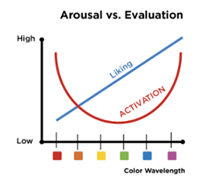The multifaceted power of colour
Did you know that the colour of our surroundings is the first thing that pops into our eye? Not the shape or material of an object, but its colour is the first visual component registered by our brain. Unlike other mammals, humans are programmed to register colour immediately. The origin of this process lies in our evolutionary needs. As nomads, we had to be able to make fire and distinguish the ripe from the rotten berries. Reading the landscape was a necessary skill for survival.
THE INFLUENCE OF COLOURS
Now that we no longer have to seek our meals, colour has been given a different function. Although the colour of our environment is no longer a matter of life or death, it still plays a major role in our daily lives. Various studies have already been conducted to demonstrate the influence of colour on consumers. What do consumers expect when they see the colour of a packaging? What grabs their attention? What will gain their trust? What drives them to buy? Theoretically, the impact of colour can only be explained in a single graph.
Warm vs. cool colours

 The graph demonstrates that warm colours, such as red, orange and yellow, activate you more than the cool colours, such as green, blue and purple. The latter are more calming and rational, while the former create more spontaneous reactions. Activation is at its peak with red shades, decreases with cool colours and rises again when evolving towards magenta, as the colour circle comes back to red. As far as the colour preference is concerned, we notice that blue and indigo shades score best. Warm colours are less popular.
The graph demonstrates that warm colours, such as red, orange and yellow, activate you more than the cool colours, such as green, blue and purple. The latter are more calming and rational, while the former create more spontaneous reactions. Activation is at its peak with red shades, decreases with cool colours and rises again when evolving towards magenta, as the colour circle comes back to red. As far as the colour preference is concerned, we notice that blue and indigo shades score best. Warm colours are less popular.
Energetic vs. discrete colours
In addition to the ‘temperature’ of a colour, its intensity can greatly impact its effect. Each colour has its own level of chroma and greying. The higher the chroma and the lower the greying, the greater the impact of the colour. Thus the energetic and fully chromatic colours appear stronger than discrete pastels or greyed colours.
With this knowledge in mind, you can match the colour of your product, brand or company to your desired goal. In reality, however, many more factors are relevant. You have to take into account the age and gender of your consumer, as well as the setting and sector in which you are active. Finally, the geographical area in which you sell your product also plays an important role. The Color Navigator System, which has mapped more than 10,000 colours according to style, type and culture, is able to select the perfect colour for your product, brand or company and thus dramatically increase the success of your product range.
THE COMBINATION OF COLOURS
Colour combinations allow you to create depth and movement. Although you can play it safe with a harmonious color palette, you can make a conscious statement with daring combinations. Finding the right look for your product, brand or company is often based on gut feeling, but can now be supported by the Color Navigator System, which offers a scientific explanation for all your colour decisions.
Original article by iVisual, our partner in Research & Visual nudging.

